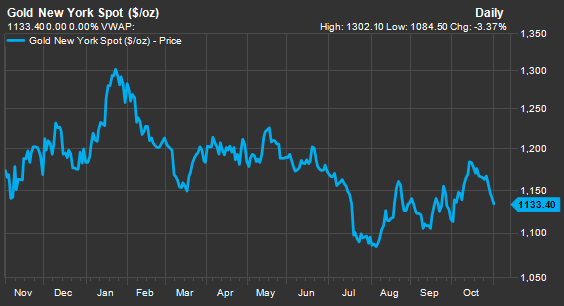How low can gold go?
Summary: Gold has been hurt by changing expectations for an increase in US interest rates and the falling gold price has snapped a rally in two Australian gold miners. Some analysts expect the gold price to weaken further, as demand from China and India does not look bright. But the supply side looks a little more promising as the volume of mined gold is expected to decrease. |
Key take-out: The gold price could regain some of its lustre by the end of 2017 but for now, analysts expect there could be more pain ahead for junior gold miners. |
Key beneficiaries: General investors. Category: Gold. |
Diwali, or the festival of lights, usually brings a gold rush to India as households splurge on jewelry and artifacts crafted from the precious metal. But, this year, gold hasn't sparkled ahead of next week's five-day holiday. The SPDR Gold Shares ETF (ticker: GLD) is down more than 4 per cent over the past five trading days.
The yellow metal has been hurt by shifting expectations for the first hike in US interest rates in a decade. The more hawkish than expected tone following last week's meeting of the Federal Open Market Committee suggested a December tightening of monetary policy may be on the cards. Higher interest rates loom as bad news for the non-yielding metal as they make cash and fixed income investments look more appealing than gold. The gold price also tends to move in the opposite direction as the US dollar, which would strengthen on higher interest rates.
The sharp downturn in the gold price, coupled with a stronger Australian dollar, has snapped a rally in Australian gold miners Northern Star Resources (NST.AU) and Evolution Mining (EVN.AU). Northern Star has tumbled 18 per cent since the beginning of last week, while Evolution is down 14 per cent. And there could be more pain ahead for the gold miners if analyst forecasts for the precious metal prove true.
Nomura analyst Yen Voo expects the gold price to weaken from current levels around $US1,140 an ounce to $US1,115 an ounce in the first half of 2016 before recovering to above $US1,200 an ounce in the second half. Besides the pressures of the looming Fed interest rate hike, Voo struggles to see fundamental support for the yellow metal. “Chinese gold demand and inflation are absent for a more sustained gold rally,” notes the analyst.
A return to $US1,115 an ounce may be bad news for Northern Star and Evolution. When gold was fetching that price in mid-September, Northern Star shares had been trading at around 21 per cent below its current level of $2.56 a share, while Evolution had been at 14 per cent below its current $1.39 a share. The 80 per cent rally in Northern Star shares since the start of the year to the end of September enticed BlackRock to lighten its position in early October, with the US fund manager cutting its stake to 10.8 per cent from 12.4 per cent. However, both miners continue to record strong production growth, underpinned by a string of acquisitions, and are enjoying healthy margins as the Australian dollar and oil prices remain weak.
But there's the possibility that gold could get beaten down to lower levels, and at a faster pace. Nomura's Voo is skeptical the Fed will hike rates in December and sees a raise in March as more likely. That's a view shared by ReOrient strategist Uwe Parpart, who argues that “the FOMC suggested at its October meeting that it will tighten in December, only to be smacked with a new round of data indicating that the Fed's belief in an improving US economy is (once again) delusional.” However, the market now sees a 50 per cent chance of a December hike, up from 35 per cent a week ago. And in the event that the US central bank does hike in December then the negative sentiment likely to envelop financial markets, on top of gold's not-so-good fundamentals, could drag the yellow metal to below $US1,100 an ounce, notes Voo.
The demand side of the gold equation does not look bright. India, the world's largest gold consumer, is set to launch two schemes to reduce the country's reliance on gold imports: a sovereign bond scheme will allow Indians to invest their gold into bonds yielding between 2 per cent and 3 per cent, while a gold monetisation scheme will allow gold owners to convert their holdings into credit in a bank account. Meanwhile, rural income growth has been hurt by weak monsoon rains this year, which could weigh on gold spending and makes a repeat of the surge in demand during last year's Diwali festival less likely.

Source: FactSet
India's northern neighbour China, the world's second largest gold consumer, is suffering from an economic slowdown that's expected to weaken demand for the yellow metal. Beijing last week lowered its GDP growth target for the 13th Five Year Plan to 6.5 per cent, down from the current 7 per cent. Nomura is forecasting even slower growth of 5.8 per cent in 2016. Besides the economic drag, jewelers in China have increased retail mark-ups on gold products, which may weigh on sales volumes and hurt gold producers. A weaker Chinese yuan also suppresses consumer appetite for gold by making it more expensive in local currency terms. Nomura's Voo estimates that a 5 per cent fall in the value of the yuan against the greenback would reduce China's gold demand by 4 per cent in 2016.
The supply side of the gold equation looks a little more promising. The volume of mined gold is expected to decrease at a 3 per cent year-on-year pace as the quality of global reserves falls. Weak gold prices have also crimped gold recycling activity. However, inventory volumes remain excessive in Asia, as indicated by the discount to spot gold prices in the region, and the problem looks especially pronounced in India, which appears to have front-loaded gold imports in August. Also hurting prices is the risk that Venezuela sells 25 per cent, or around 80 tonnes, of its gold reserves to cover maturing debt, warns Nomura's Voo.
Gold could regain some of its lustre over the longer term, with prices expected to eventually return to $US1,300 an ounce at the end of 2017. There's support from the shrinking of newly mined supply and the decline in reserve grades. Greater clarity about the trajectory of US rate hikes could also help, while demand from China is expected to improve on rising investments in gold as wealth shifts from yuan deposits to the precious metal as a store of value against declining interest rates and a weaker currency.
This piece has been reproduced with permission from Barron's.













